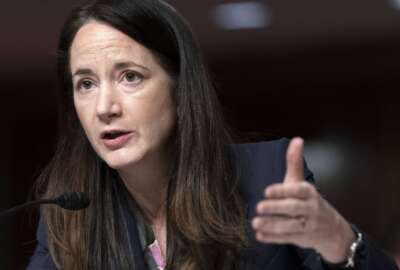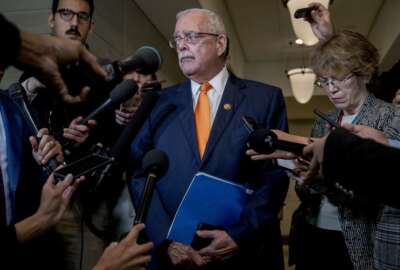AFGE takes SBA office re-entry plans to impasses panel
SBA, in an all-staff email obtained by Federal News Network, told employees on July 13 that it will bring bargaining unit employees back into the office at least...
The Small Business Administration is looking to bring another wave of employees back into the office, for at least part of every two-week pay period, starting next month.
SBA, in an all-staff email obtained by Federal News Network, told employees on July 13 that it will bring bargaining unit employees back into the office at least two days a pay period, starting Monday, Sept. 12.
But the American Federation of Government Employees local chapter that represents SBA employees says it’s at an impasse with agency management over re-entry health and safety protocols. The union is also pressing the agency to commit to a long-term vision for telework and remote work.
The all-staff email from SBA Acting Chief Operating Officer and Chief Human Capital Officer Elias Hernandez said the agency “met and completed its bargaining obligation with AFGE Local 228 in accordance with statute and the 2017 Master Labor Agreement.”
But AFGE Local 228 disputes this claim, and filed a request for assistance last week with the Federal Service Impasses Panel, which resolves disputes between unions and federal agencies when mediation assistance doesn’t result in an agreement between both parties.
Niklas Gustafsson, president of AFGE Local 228, which represents 1,200 SBA employees nationwide, said “more telework and remote work should be a feature of the post-pandemic workplace,” and the union is pressing SBA to complete a remote work policy before bringing bargaining unit employees back to the office.
“All indications we have received, both from surveying employees and from interviews we’ve read with SBA management officials, is that it’s been extremely successful and that employees have been performing better under the full telework during the pandemic than prior. The performance has increased,” Gustafsson said in an interview Monday.
Hernandez, in the all-staff email, described the upcoming office re-entry for bargaining unit SBA employees as the third wave of the agency’s office re-entry plans.
“The implementation of Phase 3 of the agency’s re-entry plan is integral in the continued support of the recovery of America’s small business community for which you play a pivotal role,” Hernandez wrote.
The email states SBA executives, supervisors and managers began working at least three days in the office per pay period on January 31, under Phase One of its office re-entry plan.
SBA began Phase Two of its re-entry plan on Feb. 14, and required non-bargaining unit employees to return to their duty stations for at least two days a pay period.
“With nearly 6-months of safe reporting to their designated duty stations, supervisors have the necessary experience working with their staff to develop onsite work schedules for their office that balance the benefits of in-person interactions with the need for following all appropriate safety protocols,” Hernandez wrote.
SBA didn’t immediately respond on Tuesday to a request for comment about its office re-entry plans.
Gustafsson said the union was notified about Phase Three office re-entry plans a few hours before it was announced at an all-staff town hall. He said he requested, but was not granted, a meeting with SBA Administrator Isabella Guzman about office re-entry concerns.
While SBA expects bargaining unit employees will return to the office “at least” two days each pay period, Gustafsson said the union is looking to clarify the maximum number of days of in-person work employees should expect.
“Anecdotally, I have heard of offices that will be providing eight days [of telework] per pay period. And anecdotally, I have heard of other offices that are planning for a greater in-office presence. And so the plan, as provided, doesn’t really provide guidance or guidelines as to when that would be appropriate and when it wouldn’t be appropriate,” he said.
Gustafsson said employees with duties that require some in-person work have returned as needed, and largely on a volunteer basis.
He said SBA has hired a number of temporary employees who are remote workers, has converted some of its employees to remote work and listed some open positions as remote jobs. However, the agency has not yet issued a remote work policy that sets baseline expectations for remote work.
“The union position is that, as part of reentry, there should be a remote work policy, and that, generally speaking, remote work and telework should be available to employees to a larger degree than it was prior to the pandemic,” Gustafsson said.
Gustafsson said AFGE Local 228 negotiated over office reentry plans with SBA management for an eight-day period, as outlined in their contract. At the end of that period, he said both parties went into mediation. Following mediation, AFGE Local 228 in mid-June submitted a number of proposals for negotiation appeal.
Gustafsson said the union has also requested additional physical barriers for employee workstations. He said the union is also asking management for health and safety steps taken at specific offices, as well as the telework policy for employees who are at high risk for COVID-19, or have high-risk member family members in their household.
“COVID is still a day-to-day fact of life reporting to the office, and more so for employees who take public transportation. Reporting back to the office is going to result in exposure to COVID, and it would be better to know what it is those in-person, in-office tasks are there they need to report to do,” Gustafsson said.
Hernandez told staff in his email that over 90% of the SBA workforce is fully vaccinated, and 92.8% of bargaining unit employees are fully vaccinated. Another 0.5% of bargaining unit employees are partially vaccinated.
Hernandez said SBA’s Facilities, Safety & Security Division has provided personal protective equipment to staff, and is working with offices to address security concerns that will ensure the safety of employees.
SBA’s COVID-19 Coordination Team, he added, continues to monitor and communicate the COVID-19 community levels across the country to ensure appropriate safety protocols are being followed at all SBA facilities, and that screening testing procedures for COVID-19, when appropriate, have been implemented.
The Biden administration, while urging the federal workforce to return to the office, also envisions a long-term future of telework for government employees.
The administration’s top personnel and management officials told House Oversight and Reform Subcommittee on Government Operations in July that telework has increased employee engagement and made the federal government more appealing to prospective hires.
Office of Personnel Management Director Kiran Ahuja said on July 21 that many federal employees now expect the work-life flexibility that telework allows, and are “agency-hopping” to more telework-friendly agencies and program offices, if not leaving government service altogether.
Republicans on the subcommittee, however, pointed to President Joe Biden’s commitment in his State of the Union Address to bring the “vast majority” of the federal workforce back to the office before the end of April as a promise that has not yet been met.
An Office of Management and Budget official told Federal News Network on Tuesday that the “federal government is leading by example” on office re-entry plans.
“With most agencies having concluded reentry by the end of April and others concluding reentry in the following weeks, the vast majority of federal employees either are or will soon be working at their official worksites and, as appropriate, doing so with updated work arrangements that advance agency missions, including delivery of federal services,” the official said.
The OMB official added that public-facing federal government offices are now open for longer hours, and more in-person appointments and walk-up services are available for individuals that need them.
“As we come back together in our workplaces, we are building on the innovations and technology that Federal agencies put to work over the last two years to make the Federal government even more efficient, resilient, and effective,” the OMB official said.
Copyright © 2025 Federal News Network. All rights reserved. This website is not intended for users located within the European Economic Area.
Jory Heckman is a reporter at Federal News Network covering U.S. Postal Service, IRS, big data and technology issues.
Follow @jheckmanWFED






